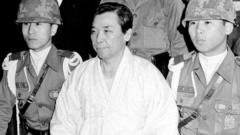In a bizarre yet captivating event, 80 contestants gathered in Seoul to participate in the Space-Out Competition, aiming to achieve a state of complete stillness and low heart rate under the watchful eyes of spectators. The journey of one participant reveals the challenges and humor embedded in this unusual contest.
The Art of "Spacing Out": A Unique Competition in Seoul

The Art of "Spacing Out": A Unique Competition in Seoul
Participants attempted to master the art of doing nothing in the annual Space-Out Competition, where relaxation meets competitiveness.
In a world that constantly demands productivity, a peculiar event takes place in Seoul aimed to highlight the importance of doing absolutely nothing: the annual Space-Out Competition. I found myself amidst a crowd of 80 others, seated cross-legged on a pink yoga mat near the scenic Han River, where contestants like myself sought to reach a zen-like state.
Despite the serene environment, a host of distractions made my attempts to zone out particularly challenging. A growing ache in my shoulders, the loud commentary from the event’s announcer, and the collective pressure from spectators only intensified my heart rate. The most significant stressor was the nagging concern of not measuring up against my fellow competitors, all equally determined to remain immobile, expressionless, and silent.
The competition lasted a grueling 90 minutes, testing our ability to endure boredom while adhering to a simple objective: to achieve the lowest and most stable heart rate. Regular intervals every 15 minutes allowed for heart rate checks, but the ultimate victor would, in addition to these metrics, also earn a popularity vote from the audience.
I joined this unusual gathering in May, enticed by the idea that taking a break for sustained stillness could somehow yield a trophy and be an act of rebellion during a busy workday. Yet, as I wrestled with the humorous contradiction—could trying so hard to win actually lead to losing the essence of relaxation?—I couldn’t help but question the purpose of it all.
As it turned out, for many, the only preparation they needed came from their habitual 'spacing out' moments in daily life. Participants reflected on their experiences in this strange yet liberating competition, encapsulating a blend of stress and a longing for tranquility in a competitive society. While initial attempts to remain still felt impossible, the laughter and shared absurdity of the event fostered a sense of camaraderie amongst participants.
Ultimately, as absurd as it seemed, the Space-Out Competition became more than just a trial of patience; it transformed into a collective enjoyment of the art of doing nothing—if just for a brief moment in time.
Despite the serene environment, a host of distractions made my attempts to zone out particularly challenging. A growing ache in my shoulders, the loud commentary from the event’s announcer, and the collective pressure from spectators only intensified my heart rate. The most significant stressor was the nagging concern of not measuring up against my fellow competitors, all equally determined to remain immobile, expressionless, and silent.
The competition lasted a grueling 90 minutes, testing our ability to endure boredom while adhering to a simple objective: to achieve the lowest and most stable heart rate. Regular intervals every 15 minutes allowed for heart rate checks, but the ultimate victor would, in addition to these metrics, also earn a popularity vote from the audience.
I joined this unusual gathering in May, enticed by the idea that taking a break for sustained stillness could somehow yield a trophy and be an act of rebellion during a busy workday. Yet, as I wrestled with the humorous contradiction—could trying so hard to win actually lead to losing the essence of relaxation?—I couldn’t help but question the purpose of it all.
As it turned out, for many, the only preparation they needed came from their habitual 'spacing out' moments in daily life. Participants reflected on their experiences in this strange yet liberating competition, encapsulating a blend of stress and a longing for tranquility in a competitive society. While initial attempts to remain still felt impossible, the laughter and shared absurdity of the event fostered a sense of camaraderie amongst participants.
Ultimately, as absurd as it seemed, the Space-Out Competition became more than just a trial of patience; it transformed into a collective enjoyment of the art of doing nothing—if just for a brief moment in time.





















